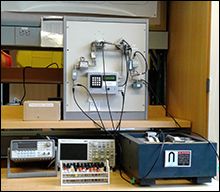Description

Spin echoes experiment equipment.
Magnetic resonances of protons in various substances are studied by the techniques of pulsed NMR and the measurement of spin echoes. Various substances containing protons (water, glycerine, etc.) are placed in a uniform magnetic field and subjected to pulses of a transverse 7.5 MHz radio frequency magnetic field in near resonance with the Larmor precession frequency of the protons.
The spin-lattice and spin-spin relaxation time constants are determined from measurements of the free-induction signals and the spin echoes produced by various combinations of rf pulses. Temperature effects are observed in glycerine, and the effects of paramagnetic ions on the relaxation time constants in water are measured. The magnetic moments of the proton and of the fluorine nucleus are derived from the data.
Lab Guide
Pulsed Nuclear Magnetic Resonance: Spin Echoes Lab Guide (PDF)
Experiment References
Bloch, F. "Nuclear Induction." The Physical Review 70, no. 7-8 (1946): 460-474.
One of the original papers on magnetic resonance of condensed matter. The majority of current NMR experiments are induction experiments as described by Bloch.
Bloembergen, N., E. M. Purcell, and R. V. Pound. "Relaxation Effects in Nuclear Magnetic Resonance Absorption." The Physical Review 73, no. 7 (1948): 679-712.
The 'other' original paper. Although the actual method used—resonance absorption—is not used very much anymore in NMR, this paper has many valuable discussions, especially on relaxation times.
Hahn, E. L. "Spin Echos." The Physical Review 80, no. 4 (1950): 580-594.
The original spin-echo paper. Besides the 'ordinary' echos discussed in great detail, this paper has a thorough description of stimulated echoes which were only sporadically used for the following two decades.
———. "Free Nuclear Induction." Physics Today 6 (November 1953): 4-9.
A 'popular' description of what we now call Hahn echoes. The cover of this particular issue of the journal had the now famous illustration of the racetrack analogy to the spin echoes.
Carr, H. Y., and E. M. Purcell. "Effects of Diffusion on Free Precession in Nuclear Magnetic Resonance." The Physical Review 94, no. 3 (1954): 630-638.
The original paper of what we now call the Carr-Purcell echo sequence. Another paper with a wealth of information (such as even-echo rephasing).
Meiboom, S., and D. Gill. "Modified Spin-Echo Method for Measuring Nuclear Relaxation Times." The Review of Scientific Instruments 29, no. 8 (1958): 688-691.
A short paper with a major modification of the Carr-Purcell sequence. Without such a modification, it is not possible to generate a long train of echoes. This is an early application of a complex multiple-pulse sequence with phase shifts which have become routine.
Melissinos, A. "Magnetic Resonance Experiments." In Chapter 8 of Techniques in Experimental Physics. New York, NY: Academic Press, 1966, pp. 340-361.
Instrumentation and Technique Reference
Ernst, R. R., and W. A. Anderson. "Application of Fourier Transform Spectroscopy to Magnetic Resonance." The Review of Scientific Instruments 37, no. 1 (1966): 93-102.
Here is a general description of how to design and build fast recovery NMR probes and receiving circuits. The quarter-wave line duplexer that is described is still a common way to decouple the receiver and the transmitter from the probe during transmission and reception, respectively.
Other Good References
Stern, Otto. Nobel Prize Lecture, "The Method of Molecular Rays." (1943).
Pake, George E. "Fundamentals of Nuclear Magnetic Resonance Absorption. I" American Journal of Physics 18, no. 8 (1950): 438-452.
———. "Fundamentals of Nuclear Magnetic Resonance Absorption. II" American Journal of Physics 18, no. 8 (1950): 473-486.
———. "Radiofrequency and Microwave Spectroscopy of Nuclei." Annu Rev Nucl Sci 4 (1954): 33-50.
Bloch, Felix. Nobel Prize Lecture, "The Principle of Nuclear Induction." (1952).
Purcell, Edward Mills. Nobel Prize Lecture, "Research in Nuclear Magnetism." (1952).
Pound, R. V. "Nuclear Paramagnetic Resonance." Progr Nuclear Phys 2, no. 21 (1952): 21-50.
Bloembergen, N. Nuclear Magnetic Relaxation: A Reprint Volume. New York, NY: W. A. Benjamin, 1961.
Feynman, Richard P., Robert B. Leighton, and Matthew Sands. "Nuclear Magnetic Resonance." In The Feynman Lectures on Physics. Vol. II. Reading, MA: Addison-Wesley, 1963, Section 35-10 to 35-12. ISBN: 9780201020106.
Harris, Robin K., and Brian E. Mann. "The Measurement of Relaxation Times." NMR and the Periodic Table. London, UK: Academic Press, 1979, pp. 41-48. ISBN: 9780123276506.
Derome, A. E. "Describing Pulse NMR." Modern NMR Techniques for Chemistry Research. Oxford, UK: Pergamon Press, 1987, pp. 85-95. ISBN: 9780080325132.
Farrar, T. C. Introduction to Pulse NMR Spectroscopy. Madison, WI: Farragut, 1987, chapters 1-2, and 4, pp. 1-54, 81-95. ISBN: 9780917903045.
Freeman, Ray. "Spin Lattice Relaxation." A Handbook of Nuclear Magnetic Resonance. Harlow, UK: Longman, 1988, pp. 251-258. ISBN: 9780582005747.
Selected Resource
A Pulse NMR experiment for an undergraduate physics laboratory (PDF)
